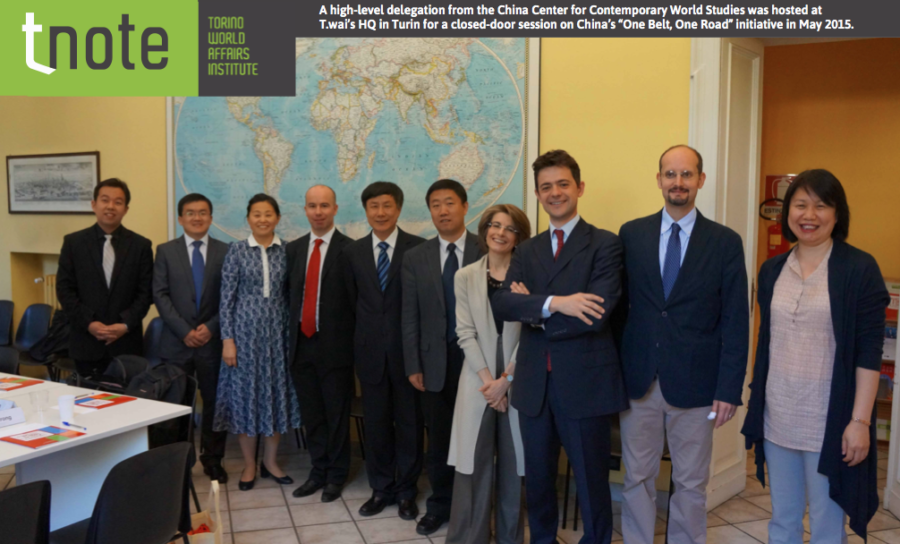
“What should we expect once China’s leaders decide that the time has come to move past their traditionally low-profile foreign policy approach?” The answer to one of the most poignant questions in international politics today was at the centre of the third round of T.wai-CCCWS track 1.5 dialogues, held in Beijing and Torino in the spring of 2015. The China Center for Contemporary World Studies is the in-house think tank of the International Department of the Communist Party of China, one of four departments under the Central Committee of the Party and since 1951 a pillar of the foreign policy and public diplomacy system of the People’s Republic of China.
When in 1978 the Chinese leadership broke with Maoist totalitarianism and kick-started an ongoing transition through economic and institutional reform, the architect of the new course, Deng Xiaoping, admonished his successors to bide their time and avoid vying for leadership in international politics. Three decades on, the fifth generation of leaders in Beijing appear to have concluded that the increasingly global nature of China’s interests and the pressure its regional ambitions are facing from the containment-through-engagement policy pursued by the US and other players across the Indo-Pacific region call for a change of pace or, according to the official formulation used by President Xi Jinping, the primus-inter-inferiores within the Chinese Party-State, a “new type of great power relations” (新型大国关系, xinxing guanxi).
Nowhere is this attempt to pursue and construe a bolder foreign policy proposition more evident than in the case of Beijing’s vision for a “Silk road economic belt and 21st-century maritime silk road” ( 一带一路, yidai yilu).
Launched by President Xi at the Kazakh University of Astana and by Premier Li Keqiang at the China-ASEAN Expo in 2013, the “Belt and Road” are designed to establish closer ties between China and the Persian Gulf and the Mediterranean Sea through Central Asia and West Asia, and to link China’s coast to Europe through the South China Sea and the Indian Ocean along an axis stretching to the South Pacific.
In defining it both as an “initiative” and a “systematic project”, the official presentation authorized by the State Council in March 2015 highlights the dualistic nature of the “Belt and Road”. On the one hand, by choosing to refer to it exclusively as an initiative (as was the case with CCCWS colleagues), Chinese analysts and officials stress its nature as an open-ended and process-oriented proposition, which is less about outcomes than it is a pursuit for a “new, inclusive and comfort-based model for international cooperation.” Emphatically not a strategy, in the words of Assistant Minister Ding Xiaowen丁孝文 the “Belt and Road” is China’s way to offer a conceptual framework for a win-win approach to Eurasian connectivity, gradually implementing measures to build “communities of shared destiny” with a mind open to constant learning-by-doing.
It would be a mistake, however, to dismiss it merely as a sophisticated narrative to camouflage the recent effort to consolidate a number of China’s long-standing partnerships, Russia and Pakistan being prime examples. The potential of Beijing’s attempt to project its own “smart power” on a grand scale – based on commanding financial resources and its proactive breed of state-led capitalism – is manifested by the three entities tasked with managing it: the National Develoment and Reform Commission, the Ministry of Foreign Affairs, and the Ministry of Commerce.
Zhang Yansheng 张燕生, Director of the Institute for International Economics Research of the National Development and Reform Commission, speaks of a total of USD 1.2 trillion in outward foreign direct investment expected from China between 2014 and 2020, to be coupled with an estimated USD 15 trillion worth of Chinese imports from abroad over the same period, a combination capable of sustaining global growth and generating some 7 million jobs globally. It is expected that a sizable share of these benefits will be concentrated on the 4.4 billion people living in the countries touched by the “Belt and Road”.
To maximize its efficiency, the “Belt and Road” initiative will be undertaken on a plurilateral – rather than multilateral – basis, connecting countries, as well as city-hubs (as in the case of Chongqing, Wuhan and Zhengzhou in China), through progressively wider circles. Closely integrated with China’s decade-long “go out” (走出去, zou chuqu) policy promoting the international competitiveness of China’s companies, it is designed to entail economic, infrastructure, financial, people-to-people, and community-building dimensions.
Through both existing and new institutions – including the China Development Bank, the Asian Infra- structure Investm e n t Bank, and the Silk Road Fund – invest- ments will be espe- cially targeted at green development, innovation, technology, SME promotion, and inclusive development for the young.
Discussions about the “Belt and Road” are currently omnipresent in China: should the spectrum of policies mobilized by this project succeed in unleashing the potential of underde- veloped international partners not merely through injections of Chinese capital, but by the effective promotion of stability and human development, China could demonstrate that it does in fact have the ability to encompass the broader interests of its neighbors, and thus foster enduring trust.
Download


Copyright © 2025. Torino World Affairs Institute All rights reserved
